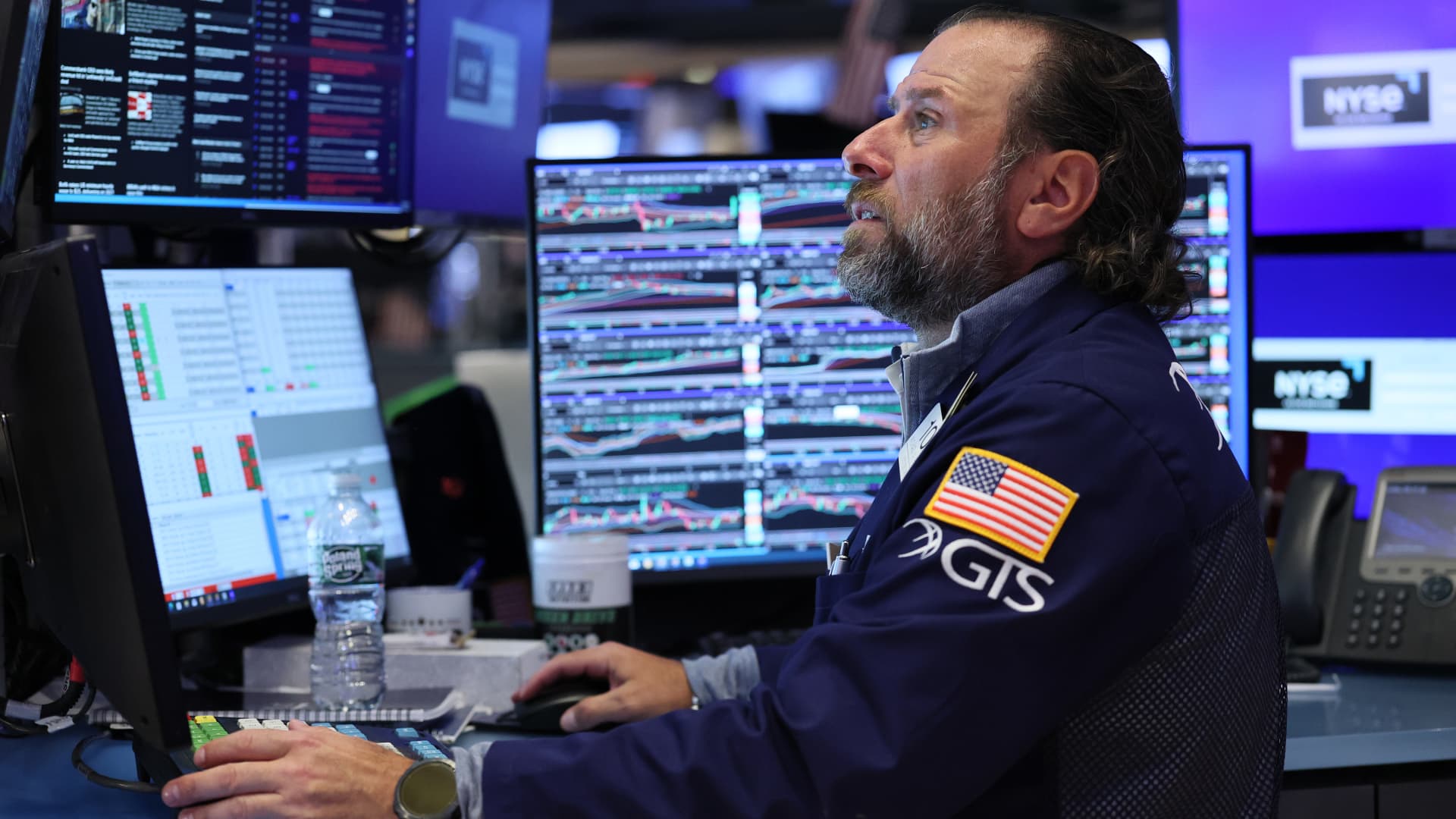
Wall Street is undergoing a minor AI-nxiety attack. Long-percolating concerns about the massive and perhaps undisciplined tech-company investments in artificial-intelligence infrastructure and the lavish valuations bestowed on these businesses started to boil over last week. And with it, a vigorous debate over whether a hazardous equity bubble is underway, on the way or in no way likely. The Wall Street Journal gave the thorough front-page treatment to the AI capex binge, squinting skeptically at the potential for payback and drawing the obvious but relevant comparisons to the Internet-broadband craze of the late-1990s. J.P. Morgan Asset Management’s esteemed big-picture strategist Michael Cembalest published a report illustrated in vintage-horror-film style called: “The Data Center Blob,” whose opening line is meant to set the scary tone: “AI related stocks have accounted for 75% of S & P 500 returns, 80% of earnings growth and 90% of capital spending growth since ChatGPT launched in November 2022.” Hedge-fund manager David Einhorn of value-oriented Greenlight Capital flagged the prospect of “massive capital losses,” while multiple articles noted the increasing use of debt financing to pay for the buildings and server racks (Oracle sold a quick $18 billion in paper last week and tech firms have issued $157 billion in corporate debt this year, up 70% over the same period on 2024). GQG Partners, a $172 billion investment manager founded in 2016 by veteran investor Rajiv Jain, which pursues a “quality growth” strategy, published an investor letter two weeks ago that was widely shared last week called “Dotcom on Steroids.” The firm, which has owned Nvidia and other tech stocks in recent years, declares, “For the first time in our firm’s history, we believe many large technology companies today—particularly those with meaningful roles in the AI infrastructure build-out — represent backward-looking quality.” The thesis is that the runaway AI buildout is being pursued just as the key markets that drive Big Tech earnings are maturing, slowing and growing more competitive, namely digital advertising and cloud services. (Side note: Few are probably aware that earnings growth in 2026 for Alphabet and Meta Platforms are projected to slow to the 6-8% range.) GQG goes on to push back against the notion that today’s tech sector is of higher quality and less overvalued, citing this chart of the S & P 500 weighting in stocks valued above 10-times revenue. By GQG’s admission, this cautious call could be quite early and is made with knowledge that it could mean forgoing appreciable upside from here. Wall Street strategists have generally resisted the bubble chatter, with Deutsche Bank saying hyperscalers have ample cash flow to invest heavily while buying back stock and Barclays noting today’s Big Tech capital outlays relative to revenues are well below those of the leveraged telecom players of the fiber-optic frenzy 25-30 years ago. The debate won’t be settled here, now or, probably, any time soon. Bubbles are rare and are conjured and misidentified during typical bull markets far more often than they arise. We may never see a comparable mania to the 1999-2000 crescendo, so the popular pastime of mapping the current ascent to the late-90s and locating us now a couple years and a huge distance from that peak could be a trap rather than a guide. On the other hand, there’s a fair chance that this latest crisis of faith in the AI theme is just what’s needed to have investors sober up a bit, rebuild a slight wall of worry, stress-test their growth models and then prolong the fun. When should we really start worrying? Which leaves open the question of how to know when to start really worrying about bubbly extremes? An initial condition would be truly extraordinary market performance that feeds upon itself, climbing at a steeper angle than we’ve seen in the current phase. The upside in the pure AI names as well as the wild speculative stuff around the edges (quantum computing, crypto-hoarding shell companies, upstart nuclear-power plays) has been extraordinary, but the broad index appreciation has been good but nothing extreme. The S & P 500’s 80%-ish gain during the current bull market that’s about to turn three years old is middle of the pack. The current trailing five-year annualized total return is 16%; at the end of 1997 is was 20%, at the end of 1998 24%. Because the starting point was higher this cycle in both valuation and broad public ownership of stocks, the market is more expensive and heavily owned. This, according to the time-tested but not ironclad market math, should mean muted equity returns in the decade to come, all else equal. But that doesn’t require or imply a bubble poised to burst. Ned Davis Research last week ran the numbers on the long-term relationship between household equity ownership as a proportion of financial assets (now at a record high) and subsequent S & P 500 performance. On this chart, the forward 10-year annual return is on an inverted scale. The relationship was tight for decades, but has loosened in the past decade in favor of better returns than history would suggest. Another feature of markets growing toward an unstable bubbly episode is volatility rising along with stock prices – counter to the broad inverse interplay. The excitable, erratic flows in 1999 drove such a phenomenon, the CBOE Volatility index rarely dropping below 20 as the S & P 500 rallied 20% and the Nasdaq Composite soared 85%. Today, the VIX has only poked above 20 for a few days over the past four months of steady index gains. Which is not to say that the current market lacks for some volatility anomalies, only that they’re more nuanced. The correlation among S & P 500 stocks over the past three months is at a decade low, suppressing index movement but keeping things jumpy below the surface. Bespoke Investment Group notes that the only group of stocks in a strong uptrend right now are the most-volatile 10% within the S & P 500. And Goldman Sachs equity desk pointed out Friday, “Something that continues to be extremely palpable while trading is how muted the volatility of the index is relative to the underliers…The average NDX stock is now 2.65x as volatile as NDX index – matching the record highs we saw in April 2017 (measured on a 3m realized basis).” Nothing particularly worrisome happened soon after April 2017, the market stayed in a tight uptrend for another nine months, relying then as now on elegant rotations – until in February 2018 the pent-up energy burst forth in the “Volmageddon” correction. A common distinction drawn between the 2025 environment and everyone’s favorite bubble moment in the days of Pets.com is the lower pace of IPO and other stock issuance, which is keeping the equity supply/demand equation favorable given still-heavy corporate buybacks and strong fund inflows. Total year-to-date equity supply this year has been $180 billion, according to Dealogic, dwarfed by the $1 trillion pace of buybacks. It’s true that the rush of sketchy IPOs eventually swamped the tape in 2000. Still, today’s capital markets are getting plenty promiscuous, with the craze for those penny stocks being hijacked to warehouse crypto assets, private credit chasing after borrowers with a glut of investor capital and 2021-vintage meme stocks being revived by buying stampedes. This falls more into the realm of tactical concerns at this point, rather than evidence of some kind of generational peak forming. And bubbles – inflating or deflating – are not needed to have the market run up in bursts or wobble in turbulence. Other notable features of the near-term setup include the still-resilient tape, the S & P 500 refusing to come in even for a 3% pullback in almost five months, the rotational impulse allowing fatigued mega-cap-tech leadership to consolidate last week while lifting energy and other laggard groups. .SPX 6M mountain S & P 500, 6 months Still, the S & P bumped against a record intraday high of 6,699 twice last week, hinting that someone out there sees 6,700 as a suitable sell level. Core AI beneficiaries – Oracle , Micron , Broadcom – have traded poorly despite stellar results and positive news flow, while Nvidia stays stuck at late-July levels. The broad picture of a Fed leaning toward lower rates in a steady economy remains undisturbed, though some noncommittal Fed speak and sideways inflation have dented the market’s certainty about two more rate cuts this year, as the 10-year Treasury yield leaks back up to a three-week high. We again can recite the seasonal softness that in theory opens a window for pullbacks into October, even though the market has refused to bow to purported calendar-based weak spots in August and September. Something to watch out for in coming months will be the Street strategists updating 2025 index targets and rolling out their 2026 calls. Currently, the median year-end 2025 bogey is right at current levels, implying a helpful reservoir of caution. Late last year, though, the handicappers came out hot with their 2025 targets, which sent expectations high and set up investors for a nasty early-year setback, even before the tariff shock in April crushed the tape, humbled the bulls and then eventually set a trap for the bears.



